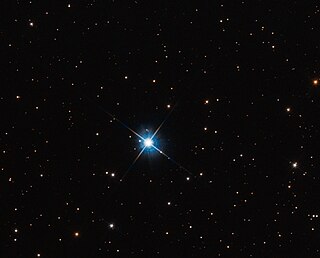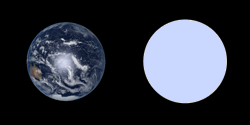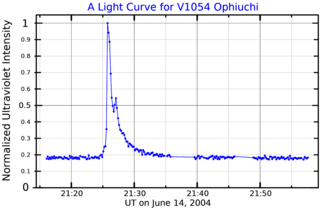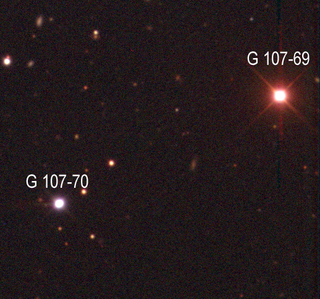Notes
- 1 2 Applying the Stefan–Boltzmann law with a nominal solar effective temperature of 5,772 K:
- .
- ↑ This is just the cooling age
| Observation data Epoch J2000 Equinox J2000 | |
|---|---|
| Constellation | Pyxis |
| Right ascension | 08h 41m 32.42908s [1] |
| Declination | –32° 56′ 32.9158″ [1] |
| Apparent magnitude (V) | 11.85 [2] |
| Characteristics | |
| Spectral type | DA5.5 |
| U−B color index | −0.59 [3] |
| B−V color index | +0.25 [4] |
| Astrometry | |
| Radial velocity (Rv) | +29.3 ± 2.9 km/s |
| Proper motion (μ) | RA: –1061.158 mas/yr [1] Dec.: 1345.900 mas/yr [1] |
| Parallax (π) | 117.3961 ± 0.0205 mas [1] |
| Distance | 27.783 ± 0.005 ly (8.518 ± 0.001 pc) |
| Absolute magnitude (MV) | 12.22±0.04 [5] |
| Details [5] | |
| Mass | 0.47±0.02 M☉ |
| Radius | 0.0148 ± 0.00092 [a] R☉ |
| Luminosity | 1.32+0.13 −0.12×10−3 L☉ |
| Surface gravity (log g) | 7.77±0.03 cgs |
| Temperature | 9,040±190 K |
| Age | 590±40 [b] Myr |
| Other designations | |
| Database references | |
| SIMBAD | data |
| ARICNS | data |
Gliese 318 is a white dwarf in the constellation Pyxis. Its spectral type is DA5.5 and it has a visual magnitude of 11.85, [2] and lies 27.8 light-years (8.5 parsecs ) away. [6]
The star was too faint to have had its parallax measured by the Hipparcos satellite. Earth-based measurement in 2009 gave its parallax as 113.63±1.97 milliarcseconds, yielding a distance of 28.7±0.5 light-years; [7] this parallax measurement has since been substantially improved by Gaia .
Gliese 318 is a rather young white dwarf with an age estimated to be 590 million years. Its temperature is around 9,000 K and it shines with 0.13 percent of the luminosity of the Sun. Like all white dwarfs, Gliese 318 is small, with just 1.5 percent the Sun's radius (1.6 R🜨), [a] but has around half the Sun's mass. [5]
Bragaglia et al. suspect this star to be a double white dwarf due to strong spectral line variations. [8] From Gaia DR2 it was not possible to confirm this claim. It is still possible that Gliese 318 is a double white dwarf and additional spectroscopic observations are needed in order to confirm this claim. [9] Gliese 318 could be the closest double white dwarf to earth. [10] [11]

Van Maanen 2, or van Maanen's Star, is the closest known solitary white dwarf to the Solar System. It is a dense, compact stellar remnant no longer generating energy and has equivalent to about 68% of the Sun's mass but only 1% of its radius. At a distance of 14.1 light-years it is the third closest of its type of star after Sirius B and Procyon B, in that order. Discovered in 1917 by Dutch–American astronomer Adriaan van Maanen, Van Maanen 2 was the third white dwarf identified, after 40 Eridani B and Sirius B, and the first solitary example.

Gliese 105 is a triple star system in the constellation of Cetus. It is located relatively near the Sun at a distance of 23.6 light-years. Despite this, even the brightest component is barely visible with the unaided eye (see Bortle scale). No planets have yet been detected around any of the stars in this system.
DENIS J1048−3956 is an exceptionally small, dim ultra-cool red dwarf star 13.2 light-years from Earth in the southern constellation of Antlia, among the stars closest to Earth. This star is very dim with an apparent magnitude of about 17, and requires a telescope with a camera to be seen. It was discovered in 2000 by Xavier Delfosse and Thierry Forveille, with the assistance of nine other astronomers.

Gliese 440, also known as LP 145-141 or LAWD 37, is a white dwarf located 15.1 light-years from the Solar System in the constellation Musca, the nearest star in this constellation. It is the fourth closest white dwarf, after Sirius B, Procyon B, and van Maanen's star. Despite its closeness, Gliese 440 is intrinsically faint with just 0.05% the luminosity of the Sun, and can't be viewed to the naked eye with an apparent magnitude of +11.5.
LHS 288 is a red dwarf around 15.8 light years from the Sun, the closest in the constellation Carina. It is far too faint to be seen with the unaided eye, with an apparent magnitude of 13.92.
LP 658-2 is a degenerate star in the constellation of Orion, the single known object in its system. It has an apparent visual magnitude of approximately 14.488.
G 240-72 is a nearby degenerate star of spectral class DQP9.0, located in constellation Draco.
L 97-12 is a nearby degenerate star, located in the constellation Volans, the single known component of the system.

G 99-47 is a nearby degenerate star of spectral class DAP8, the single known component of the system, located in the constellation Orion. G 99-47 is probably the tenth closest white dwarf, followed by Gliese 293, Gliese 518 and Gliese 915.
Wolf 489 is a nearby degenerate star of spectral class DZ10.0), the single known component of the system, located in the constellation Virgo.

WD 2359-434 is a nearby degenerate star of spectral class DAP5.8, the single known component of the system, located in the constellation Phoenix, the nearest star in this constellation.

V1054 Ophiuchi, together with the star Gliese 643, is a nearby quintuple star system. In the constellation Ophiuchus at a distance of 21.19 light-years. It consists of five stars, all of which are red dwarfs. The alternative designation of Wolf 630 forms the namesake of a moving group of stars that share a similar motion through space.
GJ 3323 is a nearby single star located in the equatorial constellation Eridanus, about 0.4° to the northwest of the naked eye star Psi Eridani. It is invisible to the naked eye with an apparent visual magnitude 12.20. Parallax measurements give a distance estimate of 17.5 light-years from the Sun. It is drifting further away with a radial velocity of +42.3 km/s. Roughly 104,000 years ago, the star is believed to have come to within 7.34 ± 0.16 light-years of the Solar System.
LHS 2090 is a red dwarf star of spectral type M6.5V, located in constellation Cancer at 20.8 light-years from Earth.
Ross 640 is a white dwarf star in the northern constellation of Hercules, positioned near the constellation border with Corona Borealis. With an apparent visual magnitude of 13.83, it is too faint to be visible to the naked eye. Its trigonometric parallax from the Gaia mission is 62.9″, corresponding to a distance of 52 light-years.

G 107-69/70 is a quadruple system, consisting of the astrometric binary G 107-69 and the resolved binary G 107-70. The system is 36.76 light years from Earth. G 107-69 and G 107-70 are separated by 103.2 arcseconds, or 1163 astronomical units (AU).